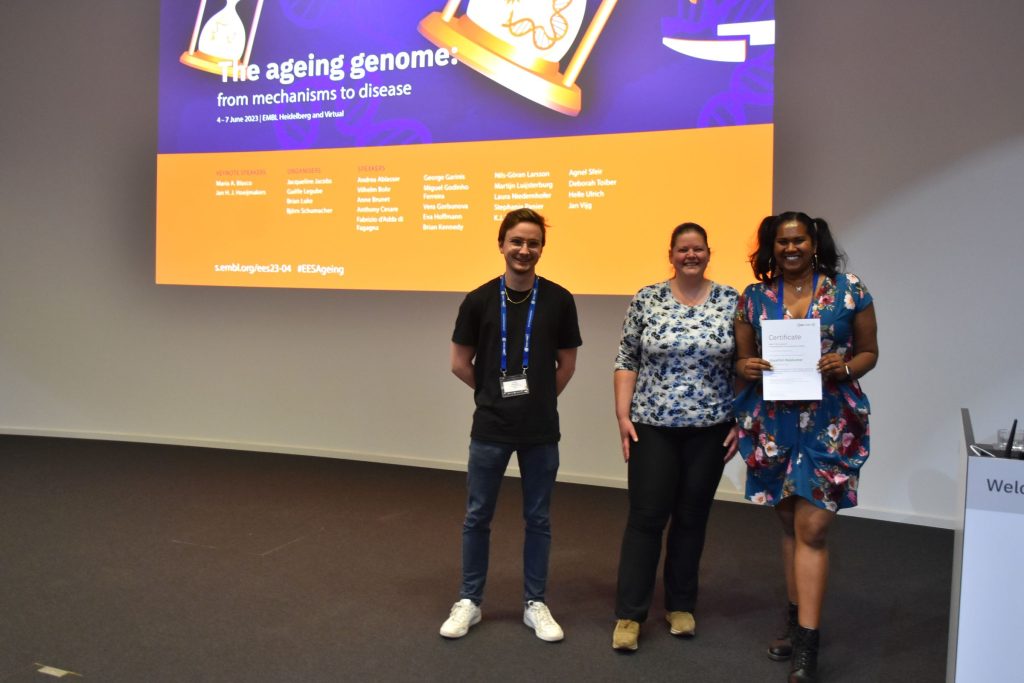Poster prizes at ‘The ageing genome: from mechanisms to disease’
The EMBO | EMBL Symposium ‘The ageing genome: from mechanisms to disease‘ took place last month and it was the first meeting of its kind. It brought together a diverse group of researchers using a breadth of experimental model systems and organisms with a focus on genome maintenance, from DNA repair to chromatin regulation. By looking at the genome maintenance specifically in the context of ageing, we gained insights into how chromosomal defects can be avoided, or even repaired during the ageing process to ensure optimal cellular function and to promote lifelong health.
We were happy to host this promising new meeting in Heidelberg, with 137 people attending on site (and 60 virtually). It was a fantastic opportunity to meet for a four days’ programme full of exciting science – exchanging ideas, presenting latest research, and making new friends. There were over 60 posters presented up on the helices of the Advanced Training Centre, with two poster sessions during which the presenters could discuss their research – their work was then voted for by other attendees and speakers. We are pleased to share with you the three best poster prize winners!
Best poster prizes:
Regulation of chromosome separation in mitosis through Lamin B1-Separase relationship in human cells
Presenter: Julien Picotto

Abstract:
Chromosomes separation at the end of mitosis is a critical event for genome stability, and failures in this process can lead for instance to endoreplication or early chromosome separation (PSC), two major sources of aneuploidy. The separase (ESPL1 in human) protein plays a crucial role in preventing aneuploidy by being responsible for chromosome separation during anaphase via the cleavage Rad21 (cohesin complex subunit), as well as centriole disengagement during anaphase via Rad21 and pericentrin cleavage. Accordingly, misregulation of ESPL1 leads to important ploidy defects. Indeed, a defect in ESPL1 is associated with the appearance of diplochromosomes (endoreplication) and supernumerary centrosomes, whereas an overexpression of ESPL1 leads to sever chromosome instability including PSC. Here, we report the first molecular evidence linking Separase to a nuclear envelope protein. Indeed, we uncover a new protein interaction between Separase and lamin B1, a key component of the nuclear envelope. Lamin B1 is essential for nuclear integrity and is involved in various cellular processes including senescence, DNA replication, DNA repair, chromatin organization and mitosis. Abnormal lamin B1 levels have been reported in several cancer types and correlate with their aggressiveness and grade for many of them. In the lab, we recently reported the involvement of lamin B1 in telomere maintenance. In addition, we now show that lamin B1 dysregulations induce opposite phenotypes to those associated with ESPL1 dysregulations. Indeed, lamin B1 overexpression induces endoreplication while its depletion causes PSC. This suggests a novel link between the nuclear envelope and the regulation of mitosis, and a novel regulation of ESPL1 by lamin B1. Importantly, dysregulation of lamin B1 alters ESPL1 localization in mitotic cells, and may disturb its enzymatic activity. These data suggest a new regulatory role of lamin B1 for ESPL1 driven probably by interaction between both proteins.
In conclusion, our results reveal the first link between Separase and lamin B1, and more generally with nuclear envelope proteins. We also shed light on a new level of Separase regulation in human cells. Finally, we highlight the importance of lamin B1 for proper chromosome segregation and its importance for the maintenance of genome stability.
Due to the confidentiality of the unpublished data, we cannot share the poster.
The effects of a ketogenic diet on DNA damage response and cellular senescence pathways during chemotherapy in acute leukemia patients
Presenter: Gayathiri Rajakumar

Abstract:
Background: Chemotherapy non selectively targets both malignant and rapidly proliferating healthy cells. Cellular damage to healthy tissues causes undesirable acute and chronic side effects. Preclinical data show a ketotic state protects healthy cells from chemotherapy without affecting toxicity to cancer cells, by inhibiting the insulin/IGF 1/mTOR pathway and inducing cellular repair pathways. We hypothesise that, in humans, metabolic ketosis will provide chemo protection to healthy cells by upregulating DNA repair and inhibiting cellular senescence, while sensitising cancer cells to chemotherapy by depriving them of their main energy source, glucose.
Aim: To analyse the effects of chemotherapy on healthy and leukemic cells in subjects with acute leukaemia randomised to either a ketogenic or control diet.
Methods: Changes in markers of DNA repair, cellular senescence and proliferation were analysed using flow cytometry in healthy and cancer cells from patients pre , during, and post chemotherapy treatment.
Results: Preliminary data at 24 and 48 hrs of chemotherapy showed increased y H2AX expression in leukemic cells in subjects receiving a ketogenic diet (n = 3) compared to the control diet (n = 4). Furthermore, non leukaemic T cells from ketogenic subjects’ post chemotherapy showed a decrease in the cellular senescence markers p16, p21 and SA β galactosidase compared to control subjects. ATM and p53 were minimally altered in both study arms.
Conclusion: Preliminary data show that a ketogenic diet increases chemotherapy induced DNA damage in leukaemic cells during chemotherapy, while it decreases cellular senescence markers in healthy lymphocytes post treatment, highlighting the potential dual role of this diet as a first line adjuvant and chemo protective therapy.
View poster (please note, parts have been greyed out due to the confidentiality of the unpublished data)
Transcription-coupled DNA-Protein Crosslink repair by non-canonical TC-NER
Presenter: Marjolein van Sluis

Abstract:
Covalent binding of proteins to DNA results in the onset of a specific type of DNA lesions known as DNA protein cross links (DPCs). DPCs are formed as intermediates of enzymatic reactions, endogenous metabolism or exogenous chemicals or irradiation. Unrepaired DPCs are highly cytotoxic, since due to their bulky characteristics. DPC form obstructions for the replication and transcription machineries. Thus far, DPCs are mostly studied in the context of replication. DPC cause replication stress, which is counteracted by the DPC specific protease SPRTN. However, how DPCs affect transcription and whether specific transcription coupled repair pathways exist remains largely elusive.
Here, we show that DPCs severely inhibit RNA polymerase 2 (Pol II) mediated transcription. Using quantitative interaction proteomics, we found that upon DPC induction mainly the transcription coupled nucleotide excision repair (TC NER) factors CSA and CSB are recruited to DPC stalled Pol II. Interestingly, we show that CSA and CSB are indispensable for DPCs repair, while downstream TC NER factors such as UVSSA and XPA are not required for the transcription coupled repair of DPCs, indicating that DPCs are repaired by a previously unknown non canonical TC NER mechanism. In line with this, we show that transcription coupled DPC repair pathway is independent of SPRTN, but that the DPCs are most likely ubiquitylated by the E3 ligase activity of CSB and CSA Cullin4 complex subsequently resulting in the VCP mediated DPC degradation by the 26S proteasome, thereby resolving the DPC and allowing unperturbed transcription.
Importantly, while Cockayne Syndrome (CS) patient cells, carrying mutations in CSA and CSB, and UV sensitive syndrome (UVSS) patient cells with mutations in UVSSA, have a similar TC NER defect, phenotypes in patients are very distinct. CS is characterised by premature ageing and progressive neurodegeneration, while UVSS is characterised by mild cutaneous phenotypes like photosensitivity. Here we show that CSA and CSB are indispensable for transcription coupled DPC repair, while UVSSA activity is indispensable. This suggests that especially endogenously produced DPCs are an important driver of the aging and neurodegenerative phenotypes observed in CS patients.
Due to the confidentiality of the unpublished data, we cannot share the poster.

The EMBO | EMBL Symposium ‘The ageing genome: from mechanisms to disease’ took place from 4 – 7 June 2023 at EMBL Heidelberg and virtually.